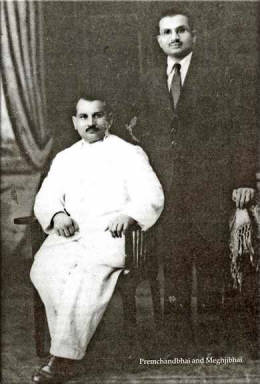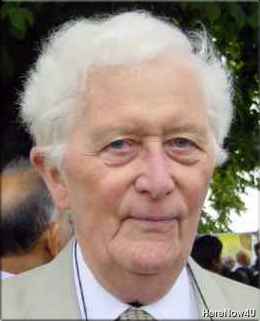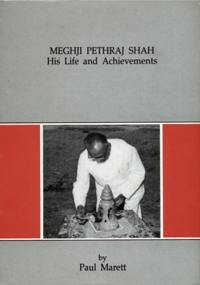
It was in 1929 that a major development took place in Meghjibhai's business life which was to be of the greatest importance for the future. One of Meghjibhai's ventures at this time was the purchase of maize, a lorry load at a time, perhaps one and a half or two tonnes, from Premchand Vrajlal Shah in Thika, a village a few miles north of Nairobi. Meghjibhai sold the maize on to a Nairobi miller, a Mr. J. Nimmo. Premchandbhai and Meghjibhai soon became firm friends: when visiting Nairobi where he had a branch business, Premchandbhai would have a meal at Meghjibhai's place and often stay the night. Premchandbhai, with his two brothers, Kachrabhai Vrajlal and Juthalalbhai Vrajlal, had various interests in the produce business and in other items as well. Soon discussions took place about a partnership and in 1929 the firm of Premchand Raichand and Co. came into existence. There were seven partners: Premchandbhai and his brothers, Meghjibhai and his brothers, and Hemrajbhai Nathoo Shah (who later became Meghjibhai's brother-in-law). The seven partners were to stay together for fourteen years. The joint resources of the two former firms gave the strength to enter large-scale projects: the capital of the new firm was raised to?10,OOO, a long way from the fourteen pounds two shillings with which Raichand Brothers had started out seven years before.

More important than the capital resources, however, was the union of two very able business minds. Premchandbhai and Meghjibhai complemented each other and in the fourteen years of their partnership both contributed to the success of their many undertakings. They remained close friends and when their partnership did eventually end in 1943, two years after Premchandbhai' s return to India, it was only their business relationship which ceased and they parted company on cordial terms. The new firm continued the business of its predecessors, the purchase and export of local commodities, which had been an important part of Premchandbhai's activities, and Meghjibhai contributed the flourishing business of Raichand Brothers to the new partnership. But soon new and more ambitious ventures took form.
It must be remembered that 1929 saw the collapse of the Wall Street stock market in the U.S.A. and the onset of a serious world depression. The prosperous industrialised countries, Britain, Germany, the United States, were badly hit. Still worse was the situation in the developing countries in Asia and Africa which were very dependent on production of those basic commodities which suffered from dramatic falls in demand and prices. Merchants saw their carefully nurtured export trade, the result of years of work, destroyed in a few months. In East Africa there was an atmosphere of gloom, of fear, almost of panic. The owners of even the largest and most solidly based enterprises were worried by their shrinking order books and accumulating bad debts. Meghjibhai' s business had expanded considerably from its small beginnings in 1922. He could not afford to look back: the only path was forward, however great the risks. In times of distress his enterprise and foresight came to his aid: his background and upbringing combined in him the rugged determination of a farmer with the practical initiative of a businessman. He could see that the depression would not last for ever.
If he could survive the bad times the longer term future was bright. To survive he needed to strike out in new ventures, not draw in his horns and retreat within his shell. It is perhaps not too fanciful to see in his determination the strong will of generations of Saurashtra farmers to survive the dry years in anticipation of the welcome rains to come.
The partnership with Gosarbhai in the transport business mentioned above was succeeded by a much larger venture in 1930 when Meghjibhai and Gosarbhai, with three other partners, formed the Kenya Builders and Timber Company. In spite of the name the company was not actually engaged in building. The main activity was quarrying stone (the company rented quarries) and supplying it to builders. They had three or four lorries. Meghjibhai was not involved in the day-to-day running of the company but took part in the business decisions. We may surmise that his commercial standing and business acumen were considerable assets to the company. He sold out his interest to his partners around 1932.
It is not easy, looking back sixty years or so, to give a coherent picture of Meghjibhai's business activities at this time. Most substantial businessmen then (and indeed the picture has not changed today) were concerned in several different enterprises at any one time which might involve a number of separate but interlocking companies, partnerships or personal interests. In the course of his business career Meghjibhai was concerned in the establishment of over fifty companies. Up to 1929, Meghjibhai's concerns were almost certainly those of Raichand Brothers, the family firm in which he was the dominant partner. It seems probable that his involvement in Kenya Builders was as an individual, not in the name of Raichand Brothers nor of the newly-formed Premchand Raichand and Co. (though of course he would not have considered his personal interests as divorced from the interests of his family).
One of the first major ventures after the formation of Premchand Raichand was the Kenya Aluminium Works Limited, registered in 1930. The use of aluminium pots and pans for domestic purposes was growing at that time. They had many advantages over the older cast-iron or tinplate wares, being lighter in weight and cheaper, yet very durable. The potential of this business caught Meghjibhai' s keen eye: the demand for aluminium vessels was considerable, both in East Africa and abroad, and the profit forecast was good. Moreover, there were not many manufacturers in the field yet, so competition would not be excessively keen. No sooner had Meghjibhai made up his mind to establish a factory for manufacturing aluminium vessels than he set the plans in motion. He was always like that: once an idea for a new venture came into his head he would not rest until he put it into motion. Meghjibhai was a man of action: ideas without action are useless. His credit with the Standard Bank of South Africa (now part of Standard Chartered) was good. The resources of the combined firm of Premchand Raichand made possible much larger scale operations than had been feasible before. The aluminium company was registered before the end of 1930. Machinery imported by a German company (which had later gone into liquidation) was purchased and in no time at all a factory was in full production in Mombasa making aluminium vessels.
Before long, a substantial trading and industrial group had come into being under the umbrella of Premchand Raichand and Co. This did not, of course, happen overnight, nor without foresight and constant hard work and attention to business by Meghjibhai and his principal partner Premchandbhai, and indeed encouragement, support and help from the other members of the partnership. One venture which proved successful around this time was the import of petroleum products, kerosene (paraffin), oil and petrol, from Romania. Petrol was shipped in drums (and sold at the controlled price of one shilling 25 cents per gallon!). This business continued up to the beginning of the Second World War but then the colonial government, favouring the big companies like Shell, made a regulation that importers must build storage tanks at Mombasa harbour and Premchand Raichand dropped out of the trade. As better times had succeeded the depression of the early thirties Meghjibhai' s foresight was vindicated and the firm of Premchand Raichand built up a substantial reputation based on business success.
 Dr. Paul Marett
Dr. Paul Marett

